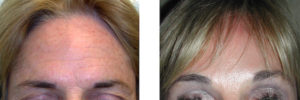
1. All forms of browlift surgery are usually only associated with a very modest amount of pain in the first few days after surgery. Most patients describe it like a headache. While pain medications are prescribed most patients only need to use them sparingly. In a few days after surgery, you should switch to Tylenol or Ibuprofen or alternate between doses with the narcotic medication.
2. There will be a circumferential head wrap placed right after surgery. This is in place to control extreme swelling and does not play a role in maintaining the new position/shape of the brow bones. You may take it on the next day after surgery. If it should get loose or come off during the night, just leave it off.
3. The sutures in the scalp or hairline incision (endoscopic or pretrichial browlifts) or in the upper eyelid (transpalpebral browlifts) are dissolveable and do not need to be removed. There is no need to apply antibiotic ointment to the incisions as all it will do is make your hair greasy and be hard to shampoo out. The same applies to the upper eyelid incisions if that approach is used.
4. Considerable bruising and swelling of the upper eyelids in particular as well as the lower eyelids will develop after browlift surgery which is perfectly normal. Maximum swelling and bruising do not occur until the second day after surgery and only begins to start to go down by day three or four after surgery.
5. You may shower and wash your hair 48 hours after surgery. There is no harm in getting your sutures wet with soap and water.
6. Your forehead will feel stiff and may not move normally for up to a month after surgery. It will also feel numb for even longer. This is all normal and as the feeling comes back in the forehead you will experience strange sensations such as shooting pains or itching as the nerves recover. Most patients have full recovery of feeling by 6 to 8 weeks after surgery.
7. You may wear any type of hat or head wear around your forehead whenever you feel comfortable doing so.
8. There are no restrictions on normal daily activities after the surgery. You may do light exercise anytime afterwards that you feel comfortable. But no strenuous exercise that involves bending over for three weeks after surgery.
9. You may drive within several days after the procedure, provided you are off pain medication and can react normally to driving conditions.
10. Most browlifts will look over corrected (too high) after surgery with the expected settling (dropping down) that will occur over the first month after surgery. One should nor assume the browlift position is stable (final result) until about 8 weeks after surgery.
Dr. Barry Eppley
Indianapolis, Indiana



